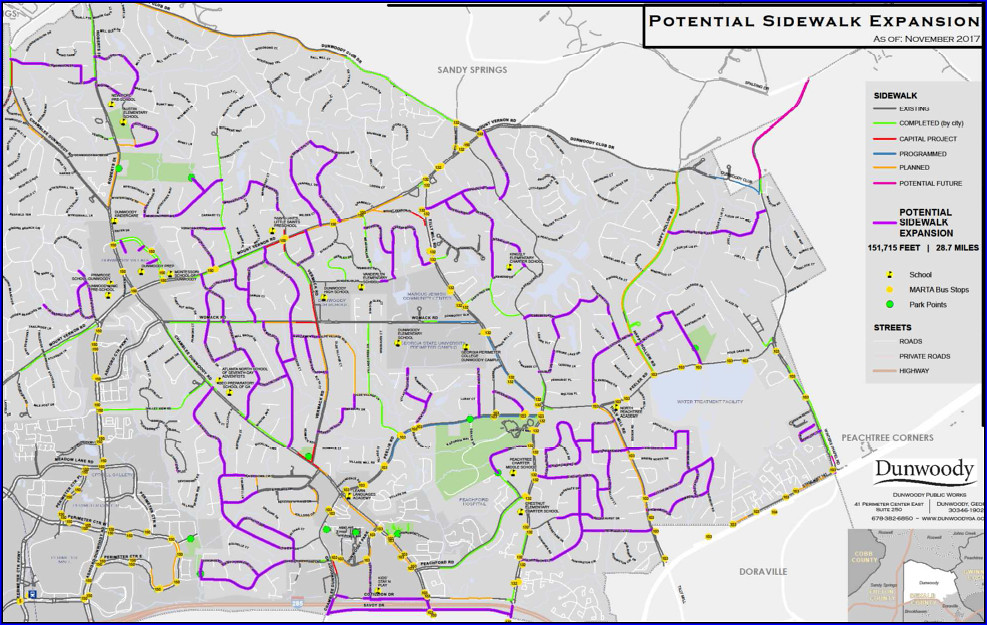Saturday, December 9, 2017
City of Dunwoody to discuss expanding sidewalks into the neighborhoods.
During deliberations on the recently adopted transportation plan update, the city council suggested that the city may want to consider a policy on the expansion of the sidewalk program into neighborhoods. The current policy primarily focuses on completing sidewalks on both sides of all arterial and collector roads. The sidewalk program has been successful in prioritizing projects and the city has completed approximately 11 miles of sidewalk in the 7 years since it was first adopted. This is about half of the total miles of sidewalk included in the program.
The presentation accompanying this agenda item provides a framework for a policy discussion about expanding the sidewalk program into neighborhoods considering other competing priorities. The presentation also includes research and best practices on uncontrolled crosswalks that staff recommends incorporating into any future update to the sidewalk policy.
Sidewalk Policy Decisions
Should city expand sidewalk program to fund sidewalks on neighborhood streets?
• Yes, include in program now OR
• Yes, but defer to current program for arterial and collector streets is closer to completion OR
• No, continue to focus limited resources on most heavily traveled roads
If the program is expanded into neighborhoods, how should neighborhood support be considered in the prioritization of projects:
• Neighborhood petition required for project to move forward OR
• Neighborhood petition not required but is a major factor in prioritizing projects OR
• Neighborhood petition not required and is a minor factor in prioritizing projects

The sound you hear is a shrieking, three-octave chorus of "NO!" Not from me, mind you, but that is the standard Dunwoody response...
ReplyDeleteI walk the neighborhoods twice a day, every day with two large dogs and would enjoy not having to think about weaponizing my poo-bags and tossing them at distracted drivers speeding along. I have never had to go to DEFCON I, but it has been close.
Providing infrastructure after the subdivisions are completed is a tough sell. Sure the City has the authority to do this, but I suspect the outcry will make the 'power line trail' hue and cry pale by comparision.
Make it so! Even before building sidewalks, first work on re-engineering all of our streets so that motor vehicles drive at the SPEED LIMIT. If a road is wide and flat, with few trees along the sides, etc., all that does it allow speeds to greatly exceed the posted limit. Adopt a Vision Zero policy so that the number one priority for all transportation dollars (new projects, repaving, etc.) put SAFETY first with the goal of having ZERO fatalities and injuries for all users (motorists, public transit riders, disabled, persons on foot or bike, etc.) https://visionzeronetwork.org/
ReplyDeleteExtract from Pedestrians.org on retrofitting sidewalks:
"The concept of Complete Streets says that every street should be designed to accommodate all the types of users it will have, motorized and non-motorized. The nature of the accommodation depends on the context, and no single street design will be suitable for every location. Nevertheless, the most common accommodation for pedestrians is the sidewalk, and there are very few populated places where sidewalks would not be appropriate.
Many places in the United States were built without sidewalks, particularly suburban areas in the decades following the Second World War. Many residents of these neighborhoods would like to improve their community by putting in the missing sidewalks. When they make a proposal to build sidewalks, they are sometimes surprised that there are people who do not want sidewalks. Who could possibly be against giving children a safe place to walk?
Sidewalk opponents will give a long list of reasons why a sidewalk should not be built on their street. It is important to listen carefully and do what can be done to address people's concerns. However, it should not be a surprise when opponents respond by coming up with an even longer list of additional reasons. It's a never-ending game of Whack-A-Mole. Much of the opposition comes down to people just not wanting change of any sort. Here are a few of the many excuses given, along with some possible responses.
No one will use it.
Everybody here drives everywhere.
No one with a disability lives in this neighborhood.
The street is so quiet that pedestrians can just walk in the road.
The street is so dangerous, we should not encourage people to walk there.
No one has ever died there.
I grew up here without sidewalks, and I'm okay.
Pedestrians prefer to walk on grass.
I might back over a pedestrian on the sidewalk when leaving my driveway.
Runners prefer to use the street.
Cars will drive faster if pedestrians are not in the street.
Trees will be cut down.
It will add to storm water runoff.
There isn't a curb and gutter.
It will increase crime.
It will ruin property values.
Pedestrians will leave trash on my lawn.
Dog walkers will leave poop on my lawn.
It will bring people too close to my house.
It will take my front lawn.
It will destroy my landscaping.
It will destroy my fence.
It will force me to park next to traffic.
It will cost me money.
Tax dollars could be better spent on other things
Other sidewalks should be built first
I will be liable if someone gets hurt.
It will take too much time to maintain.
I will have to shovel snow
There are hills or other obstacles in the way
It will ruin the "rural character" of the neighborhood.
It will ruin the "historic character" of the neighborhood
It will ruin the "Dennis the Menace character" of the neighborhood
They knew the neighborhood did not have sidewalks when they moved here."
Please go to the following link for the counterpoints to these anti-sidewalk arguments:
Reference: http://www.pedestrians.org/retrofit.htm